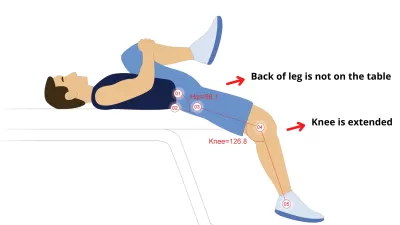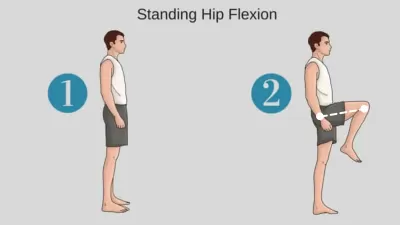Stretching is Making Tight Hip Flexors Even Tighter? Fix Hip Flexors Without Stretching
Is Stretching Making Tight Hip Flexors Even Tighter?
Tight hip flexors can be persistent and sometimes, stretching your hip flexors will not fix the issue. On the contrary, you may feel that your hip flexors are even tighter after you’ve done some classic stretches for hip flexors. Why does this happen?
As a physical therapist and a person who had an issue with front hip pain due to tightness in hip flexors, I found out that stretching is making tight hip flexors even tighter in the following situations:
The first one is stretching the hip flexors because you feel muscle tightness in your hip. Why is this wrong? Because you rely on your subjective opinion and don’t know for sure if hip flexors are tight and that stretching them will help.
You need to test hip flexor tightness before doing any stretches.
The second one is when your hip flexors are tight as a result of weak glutes or loss of trunk stabilization. Stretching the hip flexors won’t loosen up your hip flexors permanently. Often hip flexors become tight again a few hours after stretching exercises.
You may end up thinking stretching is making tight hip flexors even tighter because muscles are tight after a few weeks of constant stretching routine.
The third one is when your hip flexors are weak and tight simultaneously. Stretching hip flexors will not help you and you may feel no difference in your hip flexors after stretching exercises. I will explain below in detail.
Let’s see how you test if your hip flexors are tight or weak. Afterward, you can read the mechanism behind tight hip flexors and how you can fix hip tightness without stretching exercises.
How Do You Tell If Your Hip Flexors Are Too Tight or Too Weak?
You can perform Thomas test to see if your hip flexors are tight. Here is how:
- Sit on the edge of the table.
- Grab both legs under your knees with arms.
- Lay down on your back.
- Release one leg and let it relax on the table.
You will end up in a position like in the picture above. If you have tightness in hip flexors, two things will happen:
- The backside of your leg would rise from the table. That indicates hip flexor tightness.
- Knee extension. It would be hard to keep your knee bent at 90 degrees. That indicates tightness in your quads (m. rectus femoris).
If you are doubting results from Thomas test, you should analyze your pelvic position during the test. Too much anterior pelvic tilt signalizes tight hip flexors and muscles in front of your tight (quadriceps).
By now you probably know if you have tight hip flexors or not. Let’s move on to testing the strength of hip flexors. Here is how you can do it:
- From a standing position, lift one leg with a bent knee.
- Hold your knee in the air, above the line of your hip. (see the picture).
- Hold for the 20s.
Hip flexors are weak if:
- You can’t hold your leg in the air for 20s.
- You experience cramps in your hip muscles.
If you find out that your hip flexors are both weak and tight, you should focus first on finding out why are your hip flexors in bad form.
Let’s dive into that topic.
Why Does My Hip Flexors Keep Tightening?
Hip flexors become tight primarily when they are weak, with prolonged sitting or when glutes are weak. Having an increased anterior pelvic tilt will often drive hip flexor tightness.
To cover the topic in its entirety, I have made a list of the most common things in your every day and/or training that cause hip flexor tightness.
- Sedentary lifestyle.
- Not doing strength exercises for hip flexors.
- Neglecting glute training while overtraining your quads.
- Doing only stretching exercises for hip flexors.
- Having an anterior pelvic tilt.
Sedentary Lifestyle
A sedentary lifestyle means little to no physical activity at all. We all sit more than we should, and that may include you. What happens to your hip flexors then?
They are inactive and in a flexed position. They become weak fast, without you knowing that. Sitting for too much leads to increased anterior pelvic tilt and can eventually cause low back issues.
Not Doing Strength Exercises For Hip Flexors
Skipping strength exercises with the hip in flexion more than 90 degrees is, in my opinion, the most common reason for hip flexor tightness. Let me explain.
With hip flexion over 90 degrees, the most important hip flexor, a muscle called iliopsoas, is active. You want to activate iliopsoas every time you train your hip flexors. Otherwise, you will regret it, over time.
Your hips will become tight eventually, and you will not even notice how and when something went wrong with your hip flexors. It could be pretty frustrating.
Neglecting Glute Training While Overtraining Your Quads
Hip flexors are an antagonist muscle group to hip extensors, the glutes. They are connected in some way. If glutes are weak, hip flexors tend to be tight, and vice versa. With proper glute training, you secure hip flexor function.
Quadriceps or quads are muscles in front of your tight. One of them, the rectus femoris, helps with hip flexion. Overtraining quads will over time make your hip flexors more prone to tightness. Don’t make this mistake!
Doing Only Stretching Exercises For Hip Flexors
To loosen up your hip flexors, you need to see the bigger picture. What’s causing the tightness, how, when and to create a plan for reversing the muscle into normal muscle function.
But, most people end up trying to fix hip flexor tightness directly, with stretching exercises only. It’s not sufficient, and the effect is not long-lasting.
Don’t get me wrong, stretching can help for tight hip flexors, but it shouldn’t be the main and only solution. There is a lot more you can do to achieve great results with your hip flexors.
Having an Anterior Pelvic Tilt
The anterior pelvic tilt is a sign to analyze muscle function in the pelvic area, including hip flexors. Some muscles work more, some less when the pelvic is rotated forward. Hip flexors are prone to working more than usual with anterior pelvic tilt, so you should improve pelvic posture.
Should You Stretch Tight Hip Flexors?
Stretching tight hip flexors is a good idea only if you are one hundred percent sure that your hip flexors are shortened and tight. Then you can implement stretching exercises, but often you will need more than just static stretching exercises. Read the guide below and learn how to fix tight hip flexors without stretching them.
How Do You Fix Tight Hip Flexors Without Stretching Them?
Forget about stretching your hip flexors and focus on the following things:
- Training program for hip flexors.
- Strength exercises for glutes.
- Trunk stabilization exercises.
- Trigger point therapy for leg muscles.
Training Program For Hip Flexors
Focus on simple strength exercises for hip flexion over 90 degrees and perform movements that emphasize hip flexion. For warming up your muscles, use a foam roller. It will reduce muscle tension for a short time. Perfect for preparing your muscles for the following exercises:
- Standing knee flexion – Lift one knee as much as you can. Slowly return leg down. Keep your body at rest.
- Standing knee flexion with 5s hold – Everything is the same as above, but now you are adding more work to hip flexors with a static hold.
- Standing knee flexion with a band – Use a band around your ankle to create resistance while lifting the leg up.
The best exercises for hip flexors, in my opinion, are sprints. Running while lifting knees up is an excellent way to strengthen your hip flexors. Start from 1-2 sessions per weak and see how it goes. Afterward, you can add uphill sprints.
Strength Exercises For Glutes
- Hip bridge – Lay down on your back and bend your knees. Lift your hips up until your body is in the line. Knees, hips and shoulders should be in one line.
- Squat – Squatting is a perfect way to build your legs and glutes. Focus more on squeezing the glutes when squatting than putting more weight.
- Deadlift – Perform both standard deadlift variation and sumo. Sumo deadlift is commonly used when you want to activate glutes even more.
Trunk Stabilization Exercises
The most important hip flexor muscle, the iliopsoas attaches to the lumbar spine. Ensuring good trunk stabilization will ensure the adequate function of this part of the iliopsoas.
- Bird dog exercise – Kneel on the ground with knees and arms in line with your hips and shoulders. Extend the opposite arm and leg until your body is in line. Squeeze abs before moving your arms and legs.
- One leg standing hold – Stand on one leg and hold your body still all the time. Hold for a few minutes.
- Half-kneeling chop and lift exercise – Kneel on one leg and use a resistance band to create resistance throughout diagonal torso movement.
Trigger Point Therapy For Leg Muscles
Releasing the pressure in the leg muscles will help you feel better in general. With tight hip flexors, other leg muscles must work harder to compensate. Manual therapy or acupuncture are great ways to help you combat trigger points and restore muscle balance.
Trigger point therapy is the last on my list for treating tight hip flexors because it’s passive treatment. That means that you are not active, and because of that, I consider it as a supplement to the above-mentioned exercises, not a substitution.
Conclusion
Sometimes you can feel like stretching is making tight hip flexors even tighter when you are not seeing the results you expect after stretching hip flexors. Most of the time, you might think your hip flexors are tight, but they are usually weak and underactive. Using a simple test you can see if your muscles are tight or weak. Afterward, you can start strengthening your hip flexors, glutes and improving core stabilization.
I would like to hear your thoughts and experience on this topic. Add your comment below.


